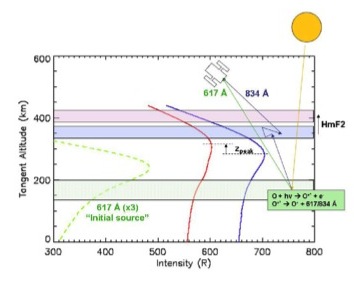The EUV instrument must make measurements of the altitude profiles of two extreme ultraviolet airglow emissions associated with positively ionized oxygen (O+), the dominant constituent of Earth's ionosphere.

Schematic of EUV ionosphere measurement
Extreme ultraviolet radiation from the sun is absorbed by O atoms in the upper atmosphere at attitudes of around 200 km. This radiation is of such high energy that it ionizes the O atoms, forming O
+. Some of these O
+ are in an excited state, and these emit light at 61.7 nm and 83.4 nm wavelengths (shown in Figure 2). It is these two wavelengths that the ICON-EUV instrument is designed to measure. The ionosphere between this airglow source at 200 km altitude and the spacecraft at 575 km is transparent at 61.7 nm, and these photos are measured directly by the instrument. At 83.4 nm, the ionosphere is optically thick – like light passing through fog, it is scattered before being measured by the ICON-EUV instrument. By comparing the two emissions, it is possible to measure the density of the O
+ layer between 200 km altitude and the spacecraft.